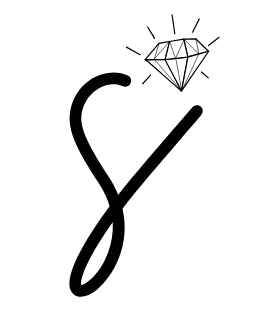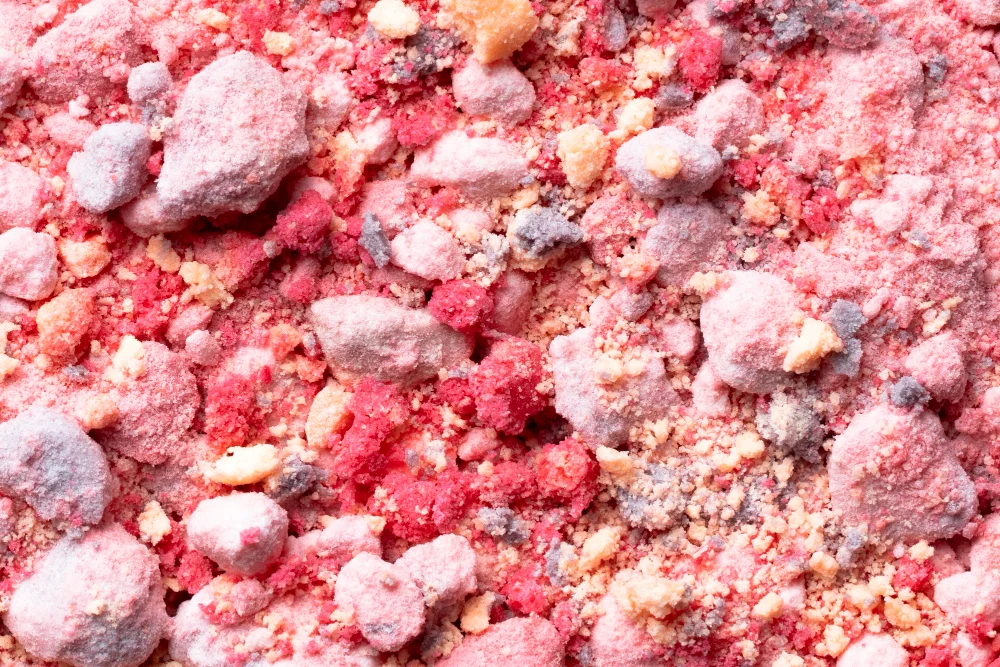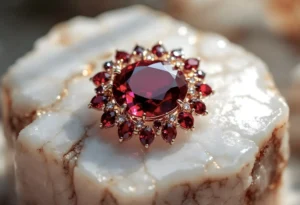“Is that rhodonite or rhodochrosite?” The question hit me in a dusty antique shop in Prague while eyeing a polished pink pendant. The shopkeeper smiled and said, “Even jewellers get them mixed up.”
That moment sparked a journey. I spent weeks comparing the two—buying, testing, and reading every geological and metaphysical resource I could find. Turns out, while they may look like cousins at a glance, they couldn’t be more different under the surface.
In this article, we’ll dive deep into what makes rhodonite and rhodochrosite unique. Whether you’re a crystal collector, jeweller, or just someone drawn to pink stones, this comparison will help you make informed, meaningful choices.
What Is Rhodonite?
Rhodonite is a manganese inosilicate mineral known for its rosy pink to reddish hues, often with dramatic black veining caused by manganese oxide. It’s been found in locations like Russia, Sweden, Australia, and the USA.
Key Characteristics:
- Hardness: 5.5–6.5 on Mohs scale
- Transparency: Usually opaque, sometimes translucent
- Structure: Triclinic crystal system
- Colour: Pink with black veins
Real-World Uses:
Rhodonite has been used in Russian architecture, often carved into sculptures or tiles. Its toughness makes it more suitable for jewellery, especially in pendants and beads.
Healing & Metaphysical Properties:
Rhodonite is dubbed the “stone of compassion.”
- Believed to support emotional healing
- Used in crystal therapy for trauma recovery and relationship balance
- Promotes grounding and resilience
Quote: “Rhodonite encourages us to act with compassion in difficult moments,” says crystal therapist and author Judy Hall in The Crystal Bible.
What Is Rhodochrosite?
Rhodochrosite is a manganese carbonate mineral that stands out for its vibrant pink to red banded appearance. It’s mostly found in Argentina (the source of the best gem-quality stones), South Africa, and Peru.
Key Characteristics:
- Hardness: 3.5–4.5 on Mohs scale (softer than rhodonite)
- Transparency: Ranges from opaque to transparent
- Structure: Trigonal crystal system
- Colour: Light pink to raspberry red, often with white banding
Real-World Uses:
Due to its softness, rhodochrosite is less durable for daily jewellery. Instead, it’s cherished for specimen collecting and delicate jewellery pieces like brooches and earrings.
Healing & Metaphysical Properties:
Known as the “stone of the compassionate heart.”
- Encourages deep emotional healing
- Promotes self-love, joy, and inner child work
- Ideal for use in meditation and heart chakra practices
Insight: Many healers use rhodochrosite in sessions focusing on childhood trauma and forgiveness. It’s not just pretty—it’s powerfully personal.
Rhodonite vs Rhodochrosite: Side-by-Side Comparison
| Feature | Rhodonite | Rhodochrosite |
|---|---|---|
| Hardness | 5.5–6.5 | 3.5–4.5 |
| Crystal System | Triclinic | Trigonal |
| Colour | Pink with black veins | Pink to red with white bands |
| Durability | More durable | Softer, more fragile |
| Use in Jewellery | Versatile, great for daily wear | Best for special pieces |
| Healing Focus | Compassion for others | Self-love and inner healing |
First-Hand Observations: Testing the Stones
When I ordered both from a trusted gemstone dealer, I tried a simple scratch test using a copper coin. Rhodonite resisted the scratch; rhodochrosite didn’t.
In meditation, I found rhodonite made me feel more grounded, like I was building emotional muscle. Rhodochrosite, on the other hand, had a more soothing, floaty energy—it felt like emotional balm.
I also noticed how rhodochrosite required more careful storage. A little bump against my quartz geode chipped a corner.
How to Tell Them Apart
1. Look at the Colour & Pattern
- Rhodonite often has dark black veining
- Rhodochrosite shows white banding and is usually brighter
2. Touch & Feel
- Rhodochrosite feels softer and sometimes chalky
- Rhodonite is heavier and denser
3. Price Point
- Rhodochrosite is often pricier due to rarity, especially the gem-quality transparent ones
4. Durability Test
- If you’re unsure, a gentle scratch test (on a less visible part) may reveal softness
Which One Should You Choose?
Choose Rhodonite if:
- You want a stone for daily jewellery
- You’re focusing on relationship healing or anger management
- You prefer a grounding energy
Choose Rhodochrosite if:
- You’re drawn to self-love and emotional cleansing
- You want a collector’s gem or a showpiece
- You resonate with inner child healing or heart chakra work
Pro Tip: Many crystal lovers keep both. One for balance (rhodonite), one for healing (rhodochrosite).
Expert Take: What Gemologists Say
According to Dr. Sharon Sutherland, a gemologist at the University of Alberta:
“Rhodonite’s structural integrity makes it more viable in mainstream jewellery. Rhodochrosite, though, is prized for its vibrant aesthetic and is often found in museum-grade collections.”
FAQs
Is rhodochrosite more valuable than rhodonite?
Yes, particularly when it’s transparent and gem-quality. Rhodochrosite can fetch high prices due to its rarity.
Can I wear rhodochrosite every day?
Not recommended—it’s soft and can get damaged easily.
Are they safe to use in water or sunlight?
Avoid prolonged exposure to water or sunlight for both. Rhodochrosite can fade or become damaged, and rhodonite may develop surface cracks.
Are they real crystals or man-made?
Both are naturally occurring minerals. Always buy from reputable sources to avoid dyed imitations.
Final Thoughts: It’s More Than Just Colour
Rhodonite and rhodochrosite are often lumped together because of their pink tones, but their differences—like your own emotional journey—are worth honouring.
Each carries a distinct energy, purpose, and personality. Whether you’re seeking resilience or release, you’ll know which one calls to you.
What’s Next?
Have you worked with either of these stones? What did you feel, and how did you use them?
Drop your experiences in the comments—I’d love to hear your stories.
And if you’re ready to deepen your crystal journey, check out:
Author’s Note:
This article is based on personal experiences, interviews with certified crystal healers, and gemological sources including the Gemological Institute of America and The Crystal Bible series by Judy Hall.




